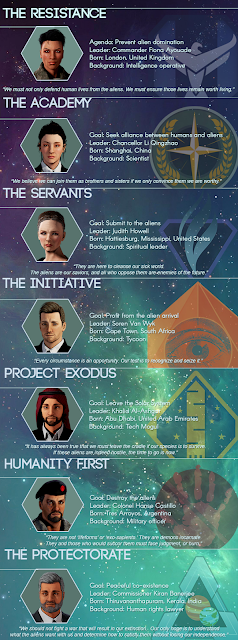Well...sort of...the second game (which sits on top of the previously mentioned one) is a space colonization simulation. It's more abstracted than say Kerbal Space Program, but there are still a number of considerations that players must make regarding where and what to scout and mine within the confines of our solar system. True to real life, launching payloads into space is less resource intensive the closer the rocket facility is to the equator. Aside from every planet and moon, a variety of large asteroids are modeled all the way out to the Kuiper Belt. This is also entirely contested territory for the various aforementioned factions since they continue to be rivals in space. The aliens are here as well, attempting to infiltrate humanity and escalating matters when they are met with failure or threats. Figuring out what they are and what they want is a mystery that the player must unravel in an echo of XCOM's tried-and-true campaign structure. The topmost game is the last players will find themselves interacting with. It's a proper space combat simulation complete with real physics models, supported by current and near future technology. Players can design their own ships and even give them maneuvering orders in combat. There is an auto-pilot feature, as well as the ability to pause the action at any time. What is lacking is a combat log, but this is an early access game so...work in progress, I suppose.
UI, AI and optimization issues aside, Terra Invicta has some general problems at the weld points between each of its three games. Balance is one way to phrase the problem, but the needed solution, fine tuning, is a tall order to fulfil given how complex it all is. To paraphrase a quote from the strategy game podcast Three Moves Ahead, "I can't believe this game doesn't immediately collapse under the weight of its own hubris." I sincerely hope we don't see too much in the way of feature creep, and in fact some simplification of certain subsystems might be the easiest way to iron out the wrinkles as the game approaches its full release. It's ambitious and interesting, but I have no desire to dive into a 40 to 100 hour long game of Terra Invicta until is has received a hefty amount of polish. To those determined individuals who are playing it extensively now though I say best of luck and I hope you have fun.Thoughts, musings, ideas and occasionally short rants on the past, present and future of electronics entertainment
Sunday, October 2, 2022
A Game Made of Games
Making a video game that consists of several smaller games (all stitched together) is a hardly a new concept. The first game I can recall playing that embraced this design aesthetic was Defender of the Crown. The oldest I ever played was almost certainly Beachhead, a game that initially released way back in 1983. Of course more recently there are a bunch of Nintendo games that fit this mold such as Wii Sports, Wii Fit, and the Mario Party series. While these sorts of games provide a nice variety of gaming experiences all rolled into a single title, there is the problem of one weak entry dragging the whole product down. The asteroid turret sequence has a notorious reputation among fans of the original Dead Space. Personally, I found turning up the in-game brightness and disabling the rumble control enough to make it a doable (although still not terribly fun) experience. To me, these sorts of diversions are only a minor annoyance, like hacking mini-games in a third-person shooter. The problem is, what if one of the uninteresting mini-games is actually a major component? I've heard people say they don't like either the tactical or strategic layer in Total War games, which sounds like a hard thing to work around as a player looking for enjoyment. Both of those "games" work in conjunction with each other to create the overall experience. Certainly it's possible to play one without the other - skirmish mode for tactile engagements only and auto-resolve for people who just want to strategize. However, I can't help but feeling that maybe Total War really isn't the series for them. So, now that the lengthy introductions are out of the way, what is the main thrust of this particular blog post? Well...to sum it up in two words: Terra Invicta.Brought to us by the same creative minds behind the Long War mods for the XCOM and XCOM 2 reboots, Terra Invicta (Latin for "unconquered land") is the name of their first stand-alone title. It definitely has some thematic similarities to the XCOM series. Unlike those games though (which are mostly about turn-based squad-sized firefights) Terra Invicta's gameplay has more in common with a lot of Paradox titles in that it is grand strategy in real-time. Upon closer examination though it isn't simply a modern version of Hearts of Iron or Europa Universalis, but actually three games stacked on top of each other. At the bottom is an incredibly detailed global domination simulation. Almost every country found in the world today is simulated via a collection of numerical values: population, GDP, wealth distribution, economic ties, cultural unity, etc. The player takes the role of one of seven different international factions, each with their own agenda and agents. The goal here is to gain control over various nations by subterfuge or military action. Things like nuclear weaponry and global warming are thrown in to enhance the sim aspect, but what makes Terra Invicta similar to XCOM is the presence of nefarious alien invaders. There's a twist though...you can take the battle to them.
Subscribe to:
Post Comments (Atom)



No comments:
Post a Comment